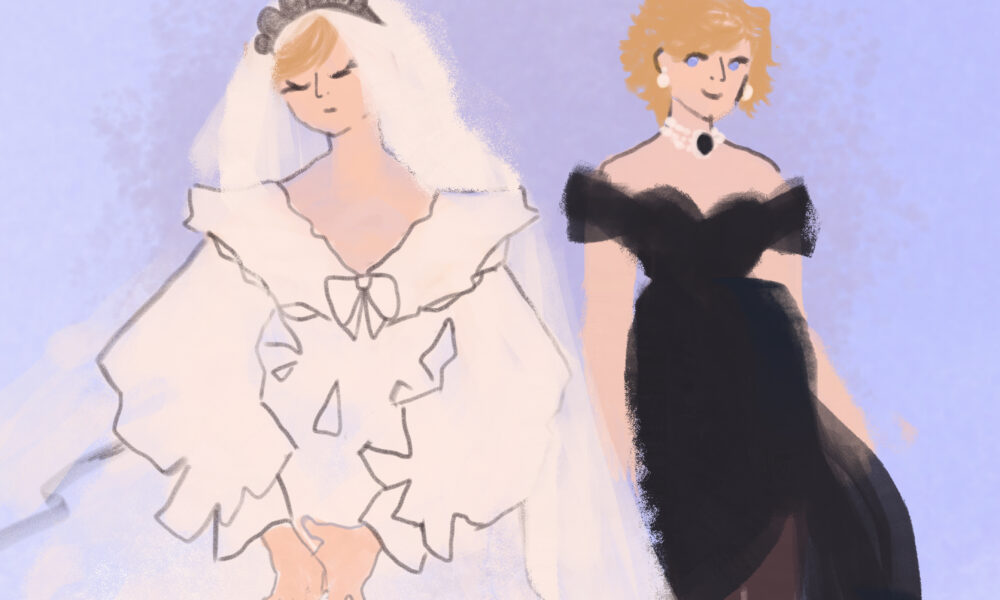Following the conclusion of Netflix’s The Crown with its sixth and final season in late 2023, I found myself drawn to the series’s portrayal of Lady Diana Spencer’s life and death. Born into British nobility and thrust into the spotlight following her 1981 marriage to now King Charles III, then Prince of Wales, Diana won the public’s attention and admiration through her beauty, charisma, and charm. Twenty-five years after her tragic passing, Diana and her life still continue to garner attention from the public and media alike.
The Crown first introduced Diana (Emma Corrin) in season four. By the end of the season, the turmoils of Royal life had changed the once innocent and naïve Diana. While showcasing the inner lives of the Royals, The Crown also emphasizes the importance of their relationship with the press and their constant concern for public opinion. The public’s perception of the royal family was a carefully constructed display crucial for maintaining their image.
Even in Andrew Morton’s biography of Diana, Diana: Her True Story, which sources most of its information directly from Diana, mediation is still involved. For example, Princess Di selectively omits aspects that might cast her in an unfavourable light, such as infidelity. So even when we are reading her biography, the truth is constructed.
Diana’s life became an overwhelming source of entertainment for the tabloids. Although seen as part of her royal responsibilities, the paparazzi dominated Diana’s relationship with the press, destroying any possibility of a positive dynamic with the media. Despite the illusion of a fairytale life in the palace, her privileges could not protect her from struggles with depression and a failing marriage. Her position in society created unique problems for her, particularly when the press invaded her privacy.
The first four episodes of season six bring a closer look into the lives of Mohamed Al-Fayed (Salim Daw) and his son Dodi (Khalid Abdalla) as the timeline quickly approaches the point of the car crash that killed both Dodi and Diana. The portrayal of the collision emphasizes Mohamed pushing his son into a relationship with Diana (now played by Elizabeth Debicki), in hopes that it would bring him closer to the Royals and help him obtain British citizenship, as the factor that ultimately led to the tabloid car chase. But this places undue and unjust blame on Mohamed when the crash is the fault of the driver’s drinking and speeding—all due to the intense pressure of trying to escape the press.
Despite my discomfort with the car crash’s framing, the story does honour the lives of Dodi and Mohamed. In one scene, an imaginary Dodi tells his grieving father that despite the Western world ignoring his death and only focusing on Diana, the Arab world is mourning him. Mohamed “shouldn’t look up to the West” because they will only disappoint him. Mohamed and Dodi’s story stresses how meaningless it is to put faith and trust in these institutions that do not care about the rest of the world.
The Crown’s portrayal of Diana, although sympathetic to both Diana and Charles’ perspectives, highlights the stark contrast between their public image and actual lives. While attempting to incorporate multiple perspectives, the show’s selection implies inherent value to those shown and a lack of value to those omitted, shaping the audience’s interpretation. Nonetheless, as a show about the monarchy, The Crown centres how situations affect the royal family above all else. It can still, however, allow critiques of the monarchy to be discussed beyond the show’s confines. Even today, despite numerous articles favouring the Royals, the turmoil during Diana’s lifetime has resurfaced with the conflict between Prince Harry and Meghan Markle and the royal family.
Diana’s story inherently exposes the royal family. While criticisms about the royals’ behaviour were initially directed toward Charles as a young Prince, his current role as king represents the entire monarchy, heightening the criticism’s gravity and legitimacy. Thus, the legacy of the People’s Princess can bring about a new wave of critique onto the Royals.








